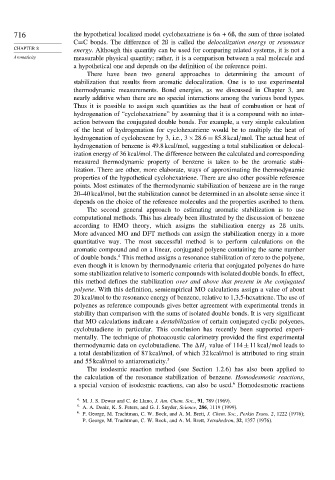Page 733 - Advanced Organic Chemistry Part A - Structure and Mechanisms, 5th ed (2007) - Carey _ Sundberg
P. 733
716 the hypothetical localized model cyclohexatriene is 6 + 6ß, the sum of three isolated
C=C bonds. The difference of 2ß is called the delocalization energy or resonance
CHAPTER 8 energy. Although this quantity can be used for comparing related systems, it is not a
Aromaticity measurable physical quantity; rather, it is a comparison between a real molecule and
a hypothetical one and depends on the definition of the reference point.
There have been two general approaches to determining the amount of
stabilization that results from aromatic delocalization. One is to use experimental
thermodynamic measurements. Bond energies, as we discussed in Chapter 3, are
nearly additive when there are no special interactions among the various bond types.
Thus it is possible to assign such quantities as the heat of combustion or heat of
hydrogenation of “cyclohexatriene” by assuming that it is a compound with no inter-
action between the conjugated double bonds. For example, a very simple calculation
of the heat of hydrogenation for cyclohexatriene would be to multiply the heat of
hydrogenation of cyclohexene by 3, i.e., 3×28 6 = 85 8kcal/mol. The actual heat of
hydrogenation of benzene is 49.8 kcal/mol, suggesting a total stabilization or delocal-
ization energy of 36 kcal/mol. The difference between the calculated and corresponding
measured thermodynamic property of benzene is taken to be the aromatic stabi-
lization. There are other, more elaborate, ways of approximating the thermodynamic
properties of the hypothetical cyclohexatriene. There are also other possible reference
points. Most estimates of the thermodynamic stabilization of benzene are in the range
20–40 kcal/mol, but the stabilization cannot be determined in an absolute sense since it
depends on the choice of the reference molecules and the properties ascribed to them.
The second general approach to estimating aromatic stabilization is to use
computational methods. This has already been illustrated by the discussion of benzene
according to HMO theory, which assigns the stabilization energy as 2ß units.
More advanced MO and DFT methods can assign the stabilization energy in a more
quantitative way. The most successful method is to perform calculations on the
aromatic compound and on a linear, conjugated polyene containing the same number
4
of double bonds. This method assigns a resonance stabilization of zero to the polyene,
even though it is known by thermodynamic criteria that conjugated polyenes do have
some stabilization relative to isomeric compounds with isolated double bonds. In effect,
this method defines the stabilization over and above that present in the conjugated
polyene. With this definition, semiempirical MO calculations assign a value of about
20 kcal/mol to the resonance energy of benzene, relative to 1,3,5-hexatriene. The use of
polyenes as reference compounds gives better agreement with experimental trends in
stability than comparison with the sums of isolated double bonds. It is very significant
that MO calculations indicate a destabilization of certain conjugated cyclic polyenes,
cyclobutadiene in particular. This conclusion has recently been supported experi-
mentally. The technique of photoacoustic calorimetry provided the first experimental
thermodynamic data on cyclobutadiene. The H value of 114±11kcal/mol leads to
f
a total destabilization of 87 kcal/mol, of which 32 kcal/mol is attributed to ring strain
and 55 kcal/mol to antiaromaticity. 5
The isodesmic reaction method (see Section 1.2.6) has also been applied to
the calculation of the resonance stabilization of benzene. Homodesmotic reactions,
6
a special version of isodesmic reactions, can also be used. Homodesmotic reactions
4 M. J. S. Dewar and C. de Llano, J. Am. Chem. Soc., 91, 789 (1969).
5 A. A. Deniz, K. S. Peters, and G. J. Snyder, Science, 286, 1119 (1999).
6
P. George, M. Trachtman, C. W. Bock, and A. M. Brett, J. Chem. Soc., Perkin Trans. 2, 1222 (1976);
P. George, M. Trachtman, C. W. Bock, and A. M. Brett, Tetrahedron, 32, 1357 (1976).

